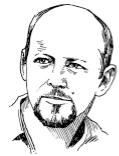Michael Light is a San Francisco–based artist and bookmaker whose work, by turns fiercely political and achingly rhapsodic, and not infrequently both at once, has come to focus, with gathering power and lucidity, on the rapture and the rupture that are man’s trace on the land.
Randomly born, as he likes to put it, in Clearwater, Florida, to a painter father and a weaver mother (who separated within months of his birth), Michael journeyed north with his mother, first to Greenwich Village (where they lived opposite E. E. Cummings’s widow) and then on out to the light-saturated flatlands around Amagansett on far eastern Long Island (Pollock, de Kooning, and Fairfield Porter country). So an abiding interest in light was more than just a matter of namesake inheritance with him (the name, for that matter, being that of his mother’s rather than his absent father’s family). Another big influence in his early years, he reports, was his mother’s father’s brother, Richard Light, “a world explorer and a great pilot in the ’30s who was actually the first person to fly around the world in a private seaplane about three years after Lindbergh crossed the Atlantic and was a grandfather figure to me and very, very glamorous.”
Michael pursued American Studies at Amherst, heading out west shortly after graduation, quickly securing work with conservationist outfits in the Bay Area and eventually tacking on an MFA in photography from the San Francisco Art Institute in 1993, focusing on landscape work from the outset (“always landscape,” as he says, though “always with a certain sense of beauty marked by violence and terror”).
Most readers, however, will have first become familiar with his name through his work compiling a man-on-the-land book of an entirely different order, the land in question being the moon, and the photos a brilliant cull (superbly rescanned) from among the thirty thousand that NASA and its astronauts had prized on the various Apollo missions. The resultant book, Full Moon—the sequence of images gorgeously choreographed by Light—proved something of a sensation when it was published in eight editions worldwide in 1999.
Light followed up his lunar work with something solar, or so he suggested in the title of his next compilation, 100 Suns, though here again his central concentration remained man’s trace on the land, in this case focusing on the years when man somehow brought the terrible energy of the sun itself down to Earth: that is, the aboveground tests, first in the American Southwest desert and then out in Micronesia, of the successive iterations of the atomic and subsequently hydrogen bombs. Seldom has Rilke’s insight into the sublime, at the outset of his...
You have reached your article limit
Sign up for a digital subscription and continue reading all new issues, plus our entire archives, for just $1.50/month.
Already a subscriber? Sign in





